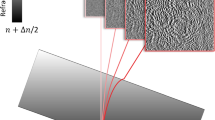Abstract
The cross correlation tracking technique is widely used to analyze image data, in Particle Image Velocimetry (PIV). The technique assumes that the fluid motion, within small regions of the flow field, is parallel over short time intervals. However, actual flow fields may have some distorted motion, such as rotation, shear and expansion. Therefore, if the distortion of the flow field is not negligible, the fluid motion can not be tracked well using the cross correlation technique. In this study, a new algorithm for particle tracking, called the Spring Model technique, has been proposed. The algorithm can be applied to flow fields which exhibit characteristics such as rotation, shear and expansion.
The algorithm is based on pattern matching of particle clusters between the first and second image. A particle cluster is composed of particles which are assumed to be connected by invisible elastic springs. Depending on the deformation of the cluster pattern (i.e., the particle positions), the invisible springs have some forces. The smallest force pattern in the second image is the most probable pattern match to the correspondent original pattern in the first image. Therefore, by finding the best matches, particle movements can be tracked between the two images. Three-dimensional flow fields can also be reconstructed with this technique.
The effectiveness of the Spring Model technique was verified with synthetic data from both a two-dimensional flow and three-dimensional flow. It showed a high degree of accuracy, even for the three-dimensional calculation. The experimental data from a vortex flow field in a cylinder wake was also measured by the Spring model technique.
Similar content being viewed by others
References
Adrian RJ (1991) Particle-imaging techniques for experimental fluid mechanics. Ann Rev Fluid Mech 23: 261
Hassan YA; Blanchat TK; Seeley Jr CH; Canaan RE (1992) Simultaneous velocity measurements of both components of a two-phase flow using particle image velocimetry. Int J Multiphase Flow 8: 371
Uemura T; Yamamoto F (1989) A High Speed Algorithm of Image Analysis for Real Time Measurement of Two Dimensional Velocity Distributions. ASME FED-85: 129
Nishino K; Kasagi N; Hirata M (1989) Three-dimensional particle tracking velocimetry based on automated digital image processing. Trans ASME J Fluid Eng 111: 384
Kaga A; Inoue Y; Yamaguchi K (1991) Application of a Fast Algorithm for Pattern Tracking on Airflow Measurements. Flow Visualization VI, Springer-Verlag, 853
Okamoto K; Madarame H; Shioya R (1991) Measurement of Velocity Distribution in a Tank by Velocity Vector Histogram. ASME, FLUCOME'91, 601
Tang YY; Suen CY (1994) New Algorithms for Fixed and Elastic Geometric Transformation Models. IEEE Trans Image Processing 34: 355
Yamamoto F; Uemura T; Iguchi M; Ohta J; Wada A; Mori K (1993) 3D PTV based on binary image correlation method and its application to a mixing flow with a bubbling jet. Comput Meth Exp Meas 229
Author information
Authors and Affiliations
Rights and permissions
About this article
Cite this article
Okamoto, K., Hassan, Y.A. & Schmidl, W.D. New tracking algorithm for particle image velocimetry. Experiments in Fluids 19, 342–347 (1995). https://doi.org/10.1007/BF00203419
Received:
Accepted:
Issue Date:
DOI: https://doi.org/10.1007/BF00203419




